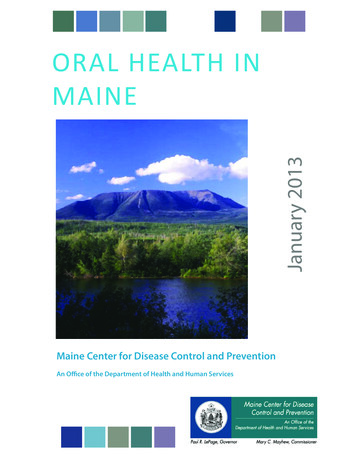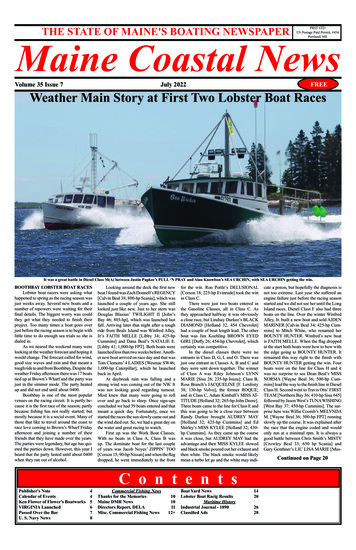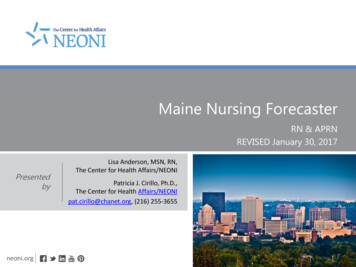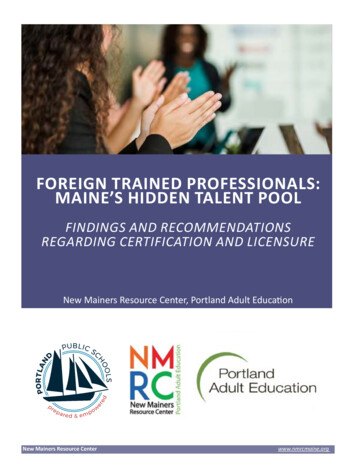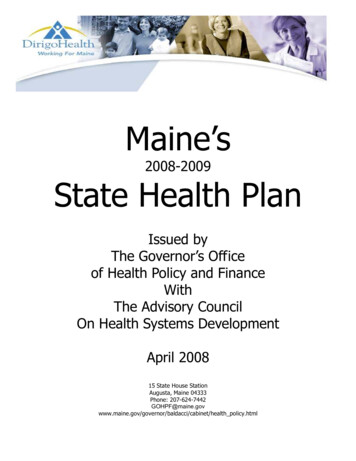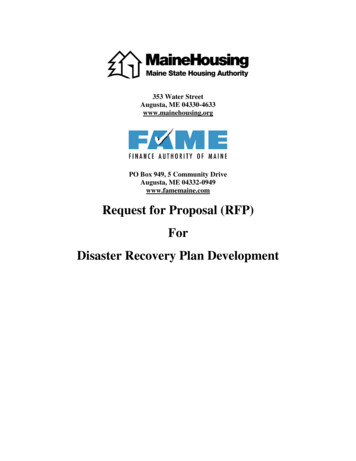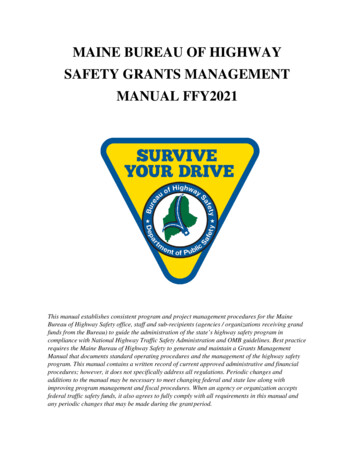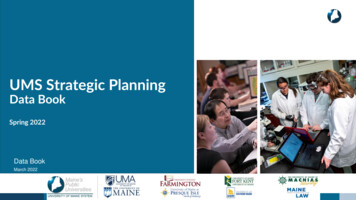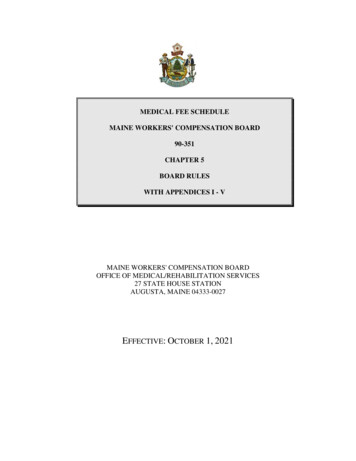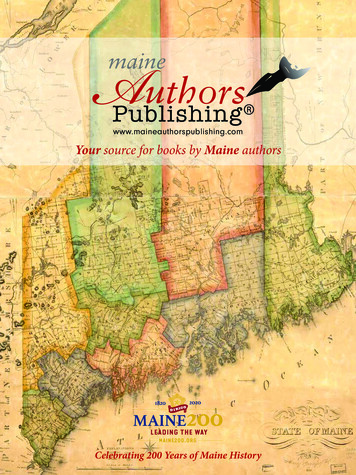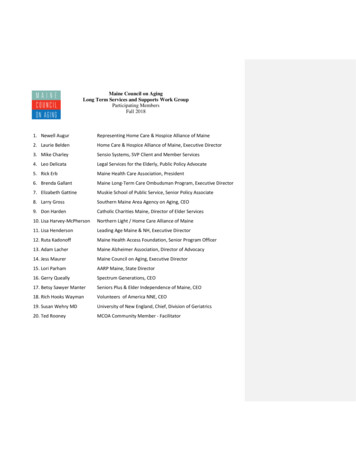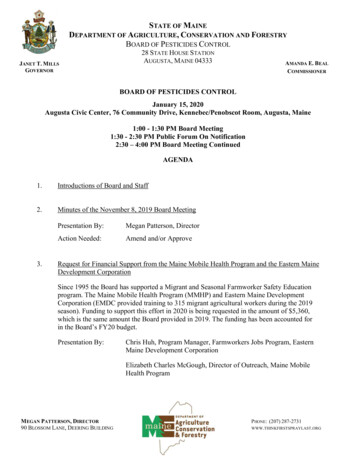
Transcription
STATE OF MAINEDEPARTMENT OF AGRICULTURE, CONSERVATION AND FORESTRYBOARD OF PESTICIDES CONTROL28 STATE HOUSE STATIONAUGUSTA, MAINE 04333JANET T. MILLSGOVERNORAMANDA E. BEALCOMMISSIONERBOARD OF PESTICIDES CONTROLJanuary 15, 2020Augusta Civic Center, 76 Community Drive, Kennebec/Penobscot Room, Augusta, Maine1:00 - 1:30 PM Board Meeting1:30 - 2:30 PM Public Forum On Notification2:30 – 4:00 PM Board Meeting ContinuedAGENDA1.Introductions of Board and Staff2.Minutes of the November 8, 2019 Board Meeting3.Presentation By:Megan Patterson, DirectorAction Needed:Amend and/or ApproveRequest for Financial Support from the Maine Mobile Health Program and the Eastern MaineDevelopment CorporationSince 1995 the Board has supported a Migrant and Seasonal Farmworker Safety Educationprogram. The Maine Mobile Health Program (MMHP) and Eastern Maine DevelopmentCorporation (EMDC provided training to 315 migrant agricultural workers during the 2019season). Funding to support this effort in 2020 is being requested in the amount of 5,360,which is the same amount the Board provided in 2019. The funding has been accounted forin the Board’s FY20 budget.Presentation By:Chris Huh, Program Manager, Farmworkers Jobs Program, EasternMaine Development CorporationElizabeth Charles McGough, Director of Outreach, Maine MobileHealth ProgramMEGAN PATTERSON, DIRECTOR90 BLOSSOM LANE, DEERING BUILDINGPHONE: (207) 287-2731WWW.THINKFIRSTSPRAYLAST.ORG
Action Needed:4.Discussion and Determination if the Board Wishes to Fund thisRequestRequest for Financial Support from the Maine State Apiarist for CLEAR TrainingMaine State Apiarist, Jennifer Lund, has requested funding to attend the National CertifiedInvestigator & Inspector Basic Training held in Raleigh, North Carolina in March 2020. Thiscourse is designed to provide training in the basics of case development. Funding to supportthis effort in 2020 is being requested in the amount of 2,000.5.Presentation By:Jennifer Lund, State ApiaristAction Needed:Discussion and Determination if the Board Wishes to Fund thisRequestRequest to Review Board Notification RequirementsFor the November 2019 meeting of the Board, Representative Pluecker provided a letterasking the Board to convene a meeting of stakeholders to discuss strengths and potentialweaknesses of the Board’s current notification rules. Representative Pluecker was unable toattend the November meeting and the Board chose to table the discussion until the January15, 2020 meeting. The Board will now continue the discussion.6.Presentation By:Megan Patterson, DirectorAction Needed:None, Informational OnlyDiscussion of Board Approved Products for Control of Browntail Moth within 250 feet ofMarine WatersOn January 25, 2008, the Board adopted Section 5 of Chapter 29 which regulates the use ofinsecticides used to control browntail moth within 250 feet of marine waters. Section 5 limitsinsecticide active ingredients to those approved by the Board. At it’s April 19, 2019 meetingthe Board received inquiries about active ingredients for removal from and addition to thelist. Subsequently, the staff was directed to update the list of approved active ingredients forbrowntail moth control. The Board will now consider the list.7.Presentation By:Pam Bryer, Pesticide ToxicologistAction Needed:Amend or Approve the List of Products for Browntail Moth ControlRequest for Funding to Support an Americorps StewardStaff are requesting funding to support the employment of an Americorp Steward. Theindividual in this position would help with editing pesticide applicator exam study manualsand reviewing applicator exams. This presents an opportunity to incorporate IPM scenariosand philosophy into these important educational tools. The applicant may also help with the
development of outreach materials that promote IPM and the proper and prudent use ofpesticides. Funding to support this temporary position is being requested in the amount of 11,000. The employment period for this position is April 20, 2020 to October 2, 2020.8.Presentation By:John Pietroski, Manager of Pesticide ProgramsAction Needed:Discussion and Determination if the Board Wishes to Fund thisRequestConsideration of Consent Agreement with Triest Ag Group, Greenville, North CarolinaThe Board’s Enforcement Protocol authorizes staff to work with the Attorney General andnegotiate consent agreements in advance on matters not involving substantial threats to theenvironment or public health. This procedure was designed for cases where there is nodispute of material facts or law, and the violator admits to the violation and acknowledges awillingness to pay a fine to resolve the matter. This case involves licensing, storage, training,and applications.9.Presentation By:Raymond Connors, Manager of ComplianceAction Needed:Approve/Disapprove the Consent Agreement Negotiated by StaffConsideration of Consent Agreement with TruGreen Lawncare, WestbrookThe Board’s Enforcement Protocol authorizes staff to work with the Attorney General andnegotiate consent agreements in advance on matters not involving substantial threats to theenvironment or public health. This procedure was designed for cases where there is nodispute of material facts or law, and the violator admits to the violation and acknowledges awillingness to pay a fine to resolve the matter. This case involves unauthorized applications,application in excessive winds, failure to post turf applications, no approved method forpositive identification of the application site, failure to report applications to wrongproperties, and failure to provide required notification to a registry member.10.Presentation By:Raymond Connors, Manager of ComplianceAction Needed:Approve/Disapprove the Consent Agreement Negotiated by StaffCorrespondencea. Email and article from Jody Spear11.Other Items of Interesta. LD 1888
12.Schedule of Future MeetingsFebruary 28, 2020; April 17, 2020; June 5, 2020; and July 24, 2020 are proposed meetingdates.Adjustments and/or Additional Dates?13.AdjournNOTES The Board Meeting Agenda and most supporting documents are posted one week before themeeting on the Board website at www.thinkfirstspraylast.org.Any person wishing to receive notices and agendas for meetings of the Board, MedicalAdvisory Committee, or Environmental Risk Advisory Committee must submit a request inwriting to the Board’s office. Any person with technical expertise who would like to volunteerfor service on either committee is invited to submit their resume for future consideration.On November 16, 2007, the Board adopted the following policy for submission anddistribution of comments and information when conducting routine business (productregistration, variances, enforcement actions, etc.):oFor regular, non-rulemaking business, the Board will accept pesticide-related letters,reports, and articles. Reports and articles must be from peer-reviewed journals. E-mail,hard copy, or fax should be sent to the Board’s office or pesticides@maine.gov. In orderfor the Board to receive this information in time for distribution and consideration at itsnext meeting, all communications must be received by 8:00 AM, three days prior to theBoard meeting date (e.g., if the meeting is on a Friday, the deadline would be Tuesday at8:00 AM). Any information received after the deadline will be held over for the nextmeeting.During rulemaking, when proposing new or amending old regulations, the Board is subject tothe requirements of the APA (Administrative Procedures Act), and comments must be takenaccording to the rules established by the Legislature.
STATE OF MAINEDEPARTMENT OF AGRICULTURE, CONSERVATION AND FORESTRYBOARD OF PESTICIDES CONTROL28 STATE HOUSE STATIONAUGUSTA, MAINE 04333JANET T. MILLSGOVERNORAMANDA E. BEALCOMMISSIONERBOARD OF PESTICIDES CONTROLNovember 8, 20199:00 AMRoom 101 Deering Building32 Blossom Lane, Augusta, MaineMINUTESPresent: Adams, Bohlen, Curtis, Jemison, Flewelling, Granger, Morrill, Waterman1.Introductions of Board and Staff 2.The Board, Assistant Attorney General Randlett, and Staff introduced themselvesStaff Present: Brown, Bryer, Connors, Couture, Patterson, Pietroski, Saucier, TomlinsonMinutes of the September 13, 2019 Board MeetingPresentation By:Megan Patterson, DirectorAction Needed:Amend and/or Approve Staff will edit the minutes, so they are titled correctly.o Waterman/Flewelling: Moved and seconded to accept minuteso In Favor: Unanimous2.Program Overview for Maine State Apiary ProgramThe State Apiarist will provide a presentation on the apiary program responsibilities andassociated activities. Highlights of program efforts from the last few years include expandedVarroa mite management and education, results from the hive survival and managementMEGAN PATTERSON, DIRECTOR90 BLOSSOM LANE, DEERING BUILDINGPHONE: (207) 287-2731WWW.THINKFIRSTSPRAYLAST.ORG
surveys, and an overall effort to provide pesticide literacy to beekeepers and pollinatorliteracy to pesticide applicators.Presentation By:Jen Lund, Maine State ApiaristAction Needed:None, Informational Only Patterson introduced the Board to Jen Lund, Maine State Apiarist. Lund thanked the Board for inviting her to the meeting. She added that this is her thirdyear anniversary as State Apiarist, and she is only the second person to hold the positionfull time since the creation of the position in 1983. Lund explained to the Board that her duties include inspecting migratory honey beecolonies, entering Maine for crop pollination and honey production, for the presence ofregulated diseases, parasites, and undesirable genetic material. She added that she mustalso issue permits for all incoming hives, of which there were just over 50,000 in 2019.Lund stated that the number has gone down some in recent years due to the low wildblueberry prices and growers not paying for pollination. Out of those 50,000 incoming hives Lund inspected 2,658 hives. She stated there wasone problem with virus and varroa mites, but that beekeeper likely will not be returningto Maine. Before hives arrive in Maine there needs to be a clean bill of health from the state oforigin. Lund told the Board she also licenses all Maine beekeepers, and this is largely done fordisease prevention so she can contact anyone in the area if a diseased hive is found. Sheadded that there are currently 1,193 resident beekeepers owning 10,058 hives. This yearLund has visited 161 of these beekeepers and inspected 1,440 of the hives. Shecommented that beekeeping was very popular at this time. Lund stated that out ofresident beekeepers almost 97% are hobby beekeepers, meaning they have less than 30hives. Lund explained that much of her time in the winter is spent doing hive autopsies Theresults show that about 70% were a result of varroa mites and viruses, 25% queen loss,starvation and/or poor winter, and 5% were everything else. Lund also sent 15 samples to the Beltsville Bee Diagnostic Lab and one case of AmericanFoulbrood was discovered as a result of those submissions. There is no fee for submittingsamples to this lab. Lund explained to the Board that she is the only employee of the Maine Apiary Programand besides her official duties she spends a great deal of time educating beekeepers andthe general public about both beekeeping and non-managed bee species. Lund explained that she sends an online survey to all licensed beekeepers each year to obtaininformation on how they are managing their hives throughout the year and what their losseswere. During 2018-19, losses were about 45.2% and they were mostly during winter. Thiswas up just slightly from the previous year’s average of 43.4%. Lund added that most losses
occur in more remote parts of the state, and there are fewer losses in places where there is astrong bee association near them. She stated that most bee losses are due to varroa mites andviruses, but that queen loss and failure are also relevant factors. Lund explained to the Board that varroa mites latch onto the abdomen and undersides andfeed on the bees’ fat bodies by digesting them and slurping them back out. Lund statedthat fat bodies are vital to insects and serve the purpose of supplying extra energy in hardtimes, serve as an immune system against disease, and help with detoxification. Sheadded that one bee can have four to five mites on them at one time. Lund said she finds that, as with most pests and diseases, integrated pest management is areally good approach to solving problems using a diversity of methods. Monitoring how thesteps taken made an impact is also very important to know if it was successful. She added thatmonitoring is so important that she wrote a grant with Massachusetts Department ofAgricultural Resources to obtain funds to distribute mite wash jars. To use the jars a half a cupof bees (about 300 bees) is put into the jar with alcohol and shaken. The jar is then dumpedinto a pan where the mites can be counted. The action threshold is nine mites per half cup ofbees. Lund stated they have about 1500 jars for Maine. She presented the idea at a national beeconference this year and other states will be adopting a similar plan. Lund told the Board that the number of beekeepers using alcohol washes has increased to about31%. She also discussed ways in which they are trying to prevent the establishment of varroamites in hives by using bottom boards and brood disruption. If that is unsuccessful the nextstep is intervention with oxalic acid, formic acid, or another product labeled for bee hives.Lund stated that using prevention and intervention together is the way to go for better hivesuccess. Lund told the Board that Maine also participates in the National Honeybee HealthSurvey, which is a USDA-APHIS program, that involves testing hives from differentparts of the state for pests and disease. Lund told the Board that our pesticide levels inwax are compared to that of other states and look pretty good. Lund commented that there was one investigation this year into suspected hive death bypesticides, but it was found to be caused by starvation. Lund explained to the Board that she conducts outreach to many groups throughout theyear, including for new beekeeper classes, UMaine Cooperative Extension, workshops,beekeeper club meetings, pesticide applicator trainings, conservation groups, land trusts,schools, libraries, Rotary clubs, and at state/national/international beekeeping meetings.She added that she spoke at this year’s Region 1 PIRT meeting about basic bee biologyand spoke with the Aroostook Band of Micmacs about non-managed bee pollinators.Lund also participated in two BPC and Cooperative Extension organized pesticideapplicator trainings this spring. Lund is currently working in rural communities such as Greenville, Houlton, andMillinocket to set up beekeeping cooperatives. Lund stated that in March 2020 she would like to attend a national certified investigatorand inspector training in Raleigh so she would be able to testify in court. She added thatanother hope was to be able to do more honey, pollen, and wax testing for the statebecause it is important to know what is really going on in the hives.
4. Lund concluded her presentation by letting the Board know that, for the first time since2003, Maine will be hosting the Eastern Apicultural Society Conference in 2020 inOrono. She explained that this is a large 5-day conference and event that usually receivesattendance from 700-900 beekeepers from all over. Patterson and the Board thanked Lund for her excellent presentation. Patterson stated thatLund has been a great partner for staff, helping to provide training to enforcement staffon hive inspections.Request to Review Board Notification RequirementsRepresentative Pluecker has asked the Board to convene a stakeholders meeting to discussstrengths and potential weaknesses of the Board’s current notification rules.Presentation By:Megan Patterson, DirectorAction Needed:None, Informational Only Patterson told the Board that there was a request from Representative Bill Pluekerregarding notification and that he would like to open the discussion about notification wecurrently do. She added that Plueker had since requested delaying this discussion untilthe January meeting so that he can attend. Patterson noted to the Board that Lauchlin Titus had, after noting that Lund would beproviding a presentation on the apiary program, submitted information on a voluntaryreporting system that he was prepared to talk about if the Board pleased. Titus stated that the program began in the Midwest to facilitate communication fromfarmer to farmer. Titus explained that he was at a meeting in Rhode Island a couple of weeks ago and hearda talk about FieldWatch, a program used in about 20 other states, developed by Purdue,and then privatized. He added that it is free to farmers and beekeepers to list locationsand free to pesticide applicators to access that information. When planning to spray,pesticide applicators can determine in real time where bees are located. Titus stated thathe did not know if we had an issue here or not but that he found the program intriguing.He added that there was an annual fee to administer the program. Patterson responded that the initial cost is 24,500 and then 5,500 annually. She addedthat FieldWatch does not do the groundwork to ensure people are reporting correctly andaccurately. Patterson added that Hive Watch also exists and is separate from FieldWatch. She stated that FieldWatch has numerous distinctions for specific datasetsincluding representation of numerous specialty crops, certified organic and non-organiccrops, and registered versus non-registered hives. Patterson commented that she wasunsure if this would pertain to the request that was brought forward, but may be worthconsidering as a part of the conversation. Granger asked if owners of hives coming into state ask anyone within 500 feet to notifythem if they are going to make an application and is 500 feet distant enough. Lund responded that that would depend on several factors.
5. Morrill asked if people could contact the state to find out the location of hives that arelicensed. Lund responded that interested parties can find out hive locations as long as the hives areregistered and placed in the locations for which they were registered. Morrill suggested delaying the conversation until the Board had a clearer idea of therequest because we are not exactly sure what is being asked. He added that hecommended the representative for reaching out to us with a specific question in lieu ofalternate paths and that he or any other Board member would be happy to speak withhim. Morrill commented that he supported Patterson’s suggestion to invite RepresentativePlueker back to speak about his specific concerns. Randlett stated that the Board always has a public forum at the Annual AgriculturalTrades Show, and this would be a good conversation for that venue. Lund had to exit the Board meeting and Morrill commented that we should continue thediscussion about FieldWatch and HiveWatch because it might be beneficial to beekeepersas well. Lund stated she would be happy to come to another meeting to discuss that. She addedshe has reached out to other state counterparts and they have had positive experienceswith HiveWatch. One of the major benefits experienced has been with mosquito sprayingin urban areas. Lund stated she could share information from counterparts in other statesas well. Morrill asked Patterson to please invite Lund to come to the meeting after the January 15,2020 meeting.Presentation and Review of the Board of Pesticides Control, DACF, State of MaineCertification PlanBoard staff prepared the State Plan, in response to the EPA revision of 40 CFR 171,Certification of Pesticide Applicators, as outlined in the Federal Register, Vol. 82, No. 2,dated January 4, 2017. The final rule became effective March 6, 2017. This State Plancompares Maine’s regulation and policies to the comparable CFR to identify actions that theState of Maine must take to comply with federal standards. These actions include revisions inregulations. The State Plan is due to EPA by March 4, 2020.Presentation By:John Pietroski, Manager of Pesticide ProgramsAction Needed:Approve/Disapprove the State Plan for Submission to EPA Pietroski told the Board that the BPC has had a state plan since the mid-1970s. He addedthat in 2017, the EPA revised FIFRA certification and training requirements which statesmust incorporate into their state plans. Pietroski said Patterson and EPA Region 1 tookthe task very seriously and began planning the changes. Pietroski stated that the plan is due March 4, 2020 to the EPA and then it will bereviewed and implemented two years after that date if it is found to comply.
Patterson commented that Pietroski did a great job pulling this together and we shouldnot have to do any additional rulemaking. Morrill asked when it would be adopted. Patterson responded that EPA will have two years to review this but the rules the BPCadopted will go into effect in January 2020. She added that most folks in Region 1 onlyneeded to make minor changes, but that was not the case with other states. Morrill asked if we had training planned for commercial applicators. Pietroski responded that we are beginning to send out informational emails to applicatorsas well as speaking about the changes at two meetings next week. A press release aboutthe changes will also be drafted and sent out.o Adams/Jemison: Moved and seconded to approve state plan for submissionto EPAo In Favor: Unanimous6.2019 Obsolete Pesticides Collection OverviewEach October the BPC, in concert with Department of Environmental Protection (DEP),conducts a program to collect and properly dispose of banned and unusable pesticides fromhomeowners, farms, and greenhouses. A summary of this year’s event, including the numberof citizens who participated, and amount of product collected, will be provided.Presentation By:Amanda Couture, Certification and Licensing SpecialistAction Needed:None, Informational Only Couture told the Board that we had 79 people participate in this year’s obsolete pesticidecollection and collected a total of 7,510 pounds—a considerable increase over the 4,680pounds collected in 2018. Morrill asked about offering the program to commercial applicators, maybe for cost. Patterson stated the tricky part would be taking the payment. Morrill said what about offering it one time without a fee Patterson responded that doing so would likely exceed the program budget. Morrill asked if there would be a benefit to adding more money to the budget. He addedthat the goal of the program was to reduce risk and remove products from the environmentand he did not feel there was a downside to offering it to another segment of thecommunity. Patterson stated that the understanding was if we extend the program to commercialapplicators and retailers there may be less impetus to purchase product responsibly—ordering only what was needed. There was discussion about the benefits and downsides of offering to the public and/orcommercial entities.
Morrill stated that his feeling was if this program is a success at this level, we could expandit to the commercial level whether we charge a fee or not.7.Progress Report on Collaborative Efforts to Reevaluate the List of Pesticide ActiveIngredients Allowed for Control of Browntail Moth Near Marine WatersAt its April 19, 2019 meeting, the board received public comment regarding the pesticideactive ingredients allowed, by policy, for management of BTM within 250 of marine waters.The board directed staff to reevaluate the list and determine what active ingredients, if any,should be added or removed. Staff will provide an update on their efforts in response to theBoard’s request.Presentation By:Pam Bryer, Pesticide ToxicologistAction Needed:None, Informational Only Bryer told the Board she was going to provide a presentation on the methodology used in the riskassessment process and present the list for review in January. She added that DACF staff had around table with applicators at which they discussed efficacious active ingredients. Bryer saidshe is currently working on risk assessments for the 42 pesticides labeled for ornamental plantsand gypsy moths. Morrill asked what this means. Bryer responded that since staff do not recommend pesticide products, we worked with theMaine Forest Service and commercial applicators to develop a list. She added that she is onlylooking at actives and there are currently 44 products that have browntail moth on their label. Forthe purposes of this assessment, MFS identified gypsy moth as a closely comparable pest. Bohlen asked Bryer to bring the list back and requested that it be organized around modesof action. Adams stated he thought it also made sense to kick off some of the obvious actives, likemancozeb, which is a fungicide. Bohlen commented that it seemed last time they discussed this there were some actives thatwere not efficacious, and we need to make sure those are removed from the final list. Bryer responded that MFS has already removed one of the actives. Heather Spaulding, MOFGA, commented that MFS had reported some data on thepathogenic fungus as an alternative to attack this pest. Patterson replied that the fungus was a universal pathogen for a lepidopteran species andMFS said they did see that have some impact, but it is also weather dependent. She addedthe Dr. Ellie Groden is doing some research on the effects of weather on the efficacy of thefungus. Patterson said that because of the weather dependence it is difficult to know if thefungus will continue to impact browntail moth populations in future years. Spaulding asked if the fungus could be bottled.
Patterson responded that it has been reported to be difficult to grow on inoculum.Apparently, infected individual caterpillars were previously utilized to spread the fungus.So yes, you can distribute this inoculum, but it is a laborious process and there’s not a goodway to grow it for increased distribution. The fungus is a generalist and would also affectlepidopteran species other than browntail moth. The Board will review the risk assessment and the proposed list at the January meeting.8.General Discussion on the Fumigation Practices and Fumigation Regulation in MaineThe use of fumigation, particularly soil fumigation, is increasing in some agricultural sectorsin Maine. By coincidence, the Board recently adopted rules on supplemental certification forprivate applicators using soil and/or non-soil fumigation application methods. These newrules will become effective January 1, 2020. Staff will facilitate a discussion about these newrules and current fumigation practices in Maine.9.Presentation By:Megan Patterson, DirectorAction Needed:None, Informational Only Patterson stated she received a call from Flewelling to put this on the agenda. She remindedthe Board that they had created new soil and non-soil fumigation categories withrulemaking, and private applicators who want to make these types of applications will needto have these supplemental categories to be able to do this work. Flewelling stated he did not remember discussing the supplemental licensing. He asked ifthere will be any training since these are a little different from our traditional commoditiesfor private licensing. Flewelling also asked if an exam had been created yet. Patterson responded that we do have plans to provide training and will be using thecommercial soil fumigation test and the national soil fumigation manual. Flewelling asked if he could take the test at the Potato Meeting in January. Adams stated that EPA training is required for those in the buffer zone and asked if onelicense holder having the supplemental category would meet the requirement if others werein the buffer zone. Patterson responded that it would, but those individuals would have to be trained ashandlers and follow all label directions.Government Evaluation Act Program Evaluation ReportDuring the first regular session of the 129th Maine legislature Board staff received a requestfrom the chairs of the Agriculture, Conservation and Forestry Committee to submit a GEAProgram Evaluation Report by November 1, 2020.Presentation By:Megan Patterson, DirectorAction Needed:None, Informational Only Patterson stated that the BPC had not done a Program Evaluation Report for seven years.
10.Funding an Education Campaign Around IPM and Other Pesticide Related TopicsAt the April 19, 2019 meeting, the Board discussed regarding education efforts to expandpublic awareness of the Board and its functions and services. Advertisement and the employof an advertising firm were determined to be an effective and efficient method of providingeducation. Staff would like to discuss tentative funding for this proposed campaign.Presentation By:Megan Patterson, DirectorAction Needed:Approve or Disapprove Funding for an Education Campaign Patterson stated that we have discussed funding an education campaign around IPM andthe reason she is bringing it back this time is to ask how much money the Board wants toapprove for staff to begin this process. Patterson told the Board that she spoke with DACF staff about the Get Real Get Mainecampaign budget for revising this promotion effort. The initial budget for this project wasapparently 300,000 for a three-year contract. She added that since then they have addedmoney to it and are up to 470,000. Patterson said that if approved, staff will develop arequest for proposals (RFP) for obtaining a contractor to develop outreach content. Shestated that it may be good to have someone from the Board sitting on the RFP reviewpanel. There was discussion amongst Board members about what a good amount to settle onwould be. Waterman asked how focused the target audience would be and if it would be gearedtowards the general public. Patterson re
Since 1995 the Board has supported a Migrant and Seasonal Farmworker Safety Education program. The Maine Mobile Health Program (MMHP) and Eastern Maine Development Corporation (EMDC provided training to 315 migrant agricultural workers during the 2019 season). Funding to support this effort in 2020 is being requested in the amount of 5,360,
